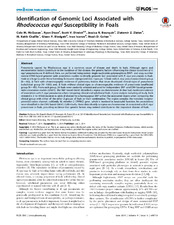| dc.creator | McQueen, Cole M. | |
| dc.creator | Doan, Ryan | |
| dc.creator | Dindot, Scott V. | |
| dc.creator | Bourquin, Jessica R. | |
| dc.creator | Zlatev, Zlatomir Z. | |
| dc.creator | Chaffin, M. Keith | |
| dc.creator | Blodgett, Glenn P. | |
| dc.creator | Ivanov, Ivan | |
| dc.creator | Cohen, Noah D. | |
| dc.date.accessioned | 2014-11-18T21:32:24Z | |
| dc.date.available | 2014-11-18T21:32:24Z | |
| dc.date.issued | 2014-06-03 | |
| dc.identifier.citation | McQueen CM, Doan R, Dindot SV, Bourquin JR, Zlatev ZZ, et al. (2014) Identification of Genomic Loci Associated with Rhodococcus equi Susceptibility in Foals. PLoS ONE 9(6): e98710. doi:10.1371/journal.pone.0098710 | en |
| dc.identifier.uri | http://dx.doi.org/10.1371/journal.pone.0098710 | |
| dc.identifier.uri | https://hdl.handle.net/1969.1/152273 | |
| dc.description.abstract | Pneumonia caused by Rhodococcus equi is a common cause of disease and death in foals. Although agent and environmental factors contribute to the incidence of this disease, the genetic factors influencing the clinical outcomes of R. equi pneumonia are ill-defined. Here, we performed independent single nucleotide polymorphism (SNP)- and copy number variant (CNV)-based genome-wide association studies to identify genomic loci associated with R. equi pneumonia in foals. Foals at a large Quarter Horse breeding farm were categorized into 3 groups: 1) foals with R. equi pneumonia (clinical group [N = 43]); 2) foals with ultrasonographic evidence of pulmonary lesions that never developed clinical signs of pneumonia (subclinical group [N = 156]); and, 3) foals without clinical signs or ultrasonographic evidence of pneumonia (unaffected group [N = 49]). From each group, 24 foals were randomly selected and used for independent SNP- and CNV-based genome-wide association studies (GWAS). The SNP-based GWAS identified a region on chromosome 26 that had moderate evidence of association with R. equi pneumonia when comparing clinical and subclinical foals. A joint analysis including all study foals revealed a 3- to 4-fold increase in odds of disease for a homozygous SNP within the associated region when comparing the clinical group with either of the other 2 groups of foals or their combination. The region contains the transient receptor potential cation channel, subfamily M, member 2 (TRPM2) gene, which is involved in neutrophil function. No associations were identified in the CNV-based GWAS. Collectively, these data identify a region on chromosome 26 associated with R. equi pneumonia in foals, providing evidence that genetic factors may indeed contribute to this important disease of foals. | en |
| dc.description.sponsorship | The open access fee for this work was funded through the Texas A&M University Open Access to Knowledge (OAK) Fund. | en |
| dc.language.iso | en_US | |
| dc.publisher | PLOS ONE | |
| dc.rights | Attribution 3.0 United States | en |
| dc.rights.uri | http://creativecommons.org/licenses/by/3.0/us/ | |
| dc.title | Identification of Genomic Loci Associated with Rhodococcus equi Susceptibility in Foals | en |
| dc.type | Article | en |
| local.department | Large Animal Clinical Sciences | en |
| dc.rights.requestable | false | en |



